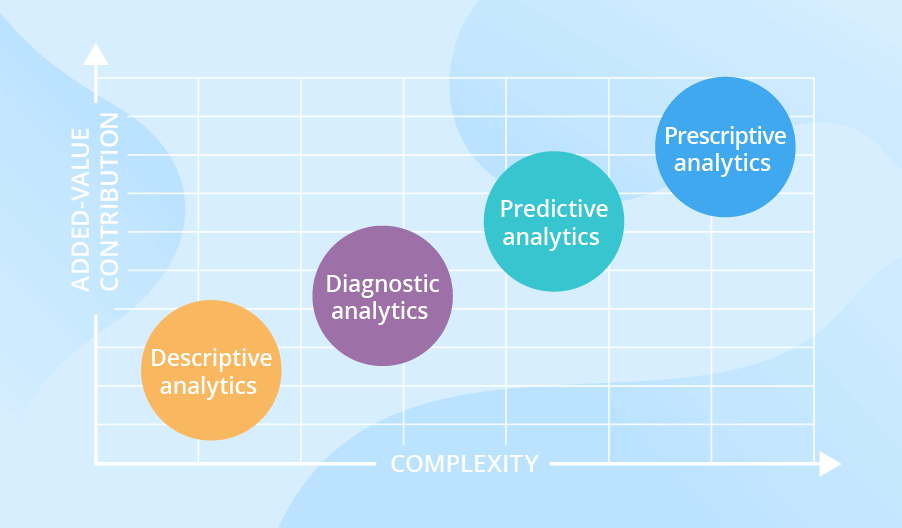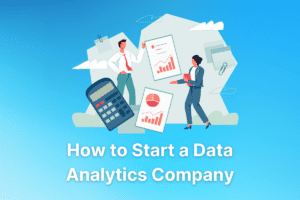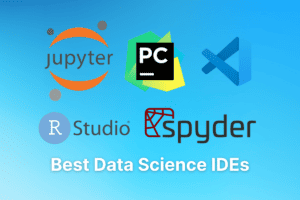Is Data Analytics Hard to Learn? (9 Things You Must Know!)
We’re reader-supported; we may earn a commission from links in this article.
There is no doubt that data analytics is a hot field right now.
With businesses of all sizes looking to gain an edge over their competition, they are turning to data analysts to help them make better decisions.
But is data analytics hard?
What skills do you need to be successful in this field? How long will it take you to learn these skills?
In this article, I will answer all of these questions and more! So if you are interested in pursuing a career in data analytics as I did, keep reading!
1. Is Data Analytics Hard?

Here’s the simple yet comprehensive answer:
Data analytics is not hard. However, learning its skills does take time to master. You will need strong analytical and problem-solving skills, a good grasp of basic mathematics, statistics, and the ability to write code. Learning data analytics takes only 6 months, and you can land a job with no data-related education.
Before I dive into why data analytics isn’t hard, we need to understand what data analytics is!
Based on my online research and my own experience in the data analytics field so far, here’s my definition.
2. What Is Data Analytics?
Data analytics is a process of analyzing large sets of data to uncover patterns and insights about trends, customer behaviors, and more. It is used to understand customer needs, predict future trends, and improve processes by uncovering hidden insights.
Here are the 4 types of data analytics services that data analysts provide:

Predictive data analytics
Predictive data analytics includes forecasting future outcomes and customer behavior. It is used for predictive maintenance, product recommendations, segmentation, customer churn analysis, customer lifetime value calculation, and more.
The very well-known use case of this is the recommendations you receive on Spotify or the Explore page on Instagram. These utilize algorithms to determine your preferences based on the past songs and posts that you’ve been looking at on their platform.
Prescriptive data analytics
Prescriptive data analytics is used to recommend optimal solutions. It is used for decision support, supply chain optimization, and resource allocation.
Diagnostic data analytics
Diagnostic data analytics is used to uncover the root cause of problems. It is used for customer service, process improvement, and quality assurance. Examples of diagnostic data analytics include customer segmentation, customer journey mapping, A/B testing, and more.
Descriptive data analytics
Descriptive data analytics is used to provide a summary of past events. It is used for customer segmentation, customer journey mapping, and more. Examples of descriptive data analytics include market sizing and forecasting, trend analysis, etc.
Overall, the main purpose of data analytics is to uncover insights and make better decisions using those insights.
3. Why Is Data Analytics Not Hard?
Now that we understand what data analytics is, let’s talk about why it is not hard.
Data analytics is not hard because it is a process that is structured in steps. This makes it easier to learn and follow the same recipe to get results.
Moreover, there are now many resources that you can find online such as YouTube channels, Discord servers, and online courses where you can learn data analytics and reach a proficiency level.
You can also explore specialized courses like the Scaler Data Science course, which provides a structured and comprehensive learning path to master the intricacies of data analytics and science.
While it may take some getting used to writing code and knowing the differences in the different data types, learning data analytics isn’t as hard as you think!
Taking an online course can speed up your career path as a data professional as it teaches you the technical skill and foundational skills needed as a data analyst or data scientist.
I’ll talk more about my journey later on in this article.
4. What Does a Data Analyst Do?
A data analyst is a person who is responsible for analyzing large sets of data to uncover patterns and insights about trends to improve business processes, increase revenue, and create better customer experiences.
Data analysts are also responsible for creating reports on their findings and presenting them to the rest of the team.
They also use data visualization tools such as Tableau and Power BI to create compelling visuals that show their findings in an easy-to-understand way.
Data analysts are also responsible for building predictive models and machine learning algorithms to uncover insights about customer behavior and future trends.
5. What Skills Do Data Analysts Need?
Data analysts need to have a range of skills such as data analysis, data visualization, programming, knowing how to code, and building machine learning models.
Data Analysis Skills
Data analysts need to know how to extract, clean, and organize large sets of raw data in order to find patterns and insights. This is also known as “data wrangling”.
Data Visualization Skills
Data analysts need to be able to visualize data in a way that is easy to understand. This is done with the help of tools such as Tableau, Power BI, and Excel.
Programming Skills
Data analysts need to know how to code in Python or R so they can create scripts that automate mundane tasks and make analyzing data more efficient. These data pipelines can be custom-made to fit the organization’s needs!
You may even need to perform some script automation using RPA software, so make sure you keep an open mind about using different programs to achieve your goals.
Machine Learning Skills
Data analysts need to be able to build predictive models and machine learning algorithms so they can uncover insights about customer behavior or future trends. Note that not all data analyst roles require you to do this, as some data teams leave this up to the data scientists.
Taking the time to learn more about machine learning is crucial, as it is something employers seek in new hires.
In fact, machine learning is one of the core concepts in AI writing tools like Jasper AI, Content at Scale, and the very popular ChatGPT, and other Large Language Models (LLMs).
Personally, I’ve taken the time to learn these skills one by one so that I can practice them whenever I needed them when I was a data analyst.
My advice for learning these skills is to look at the list of skills you need to learn and learn them in the progression I mention above: data analysis -> data visualization -> programming -> machine learning.
This way, you’ll be able to scale your learning by its difficulty.
It’s definitely much easier to start learning data analytics with software you’re familiar with, such as Excel, then followed by Tableau or Power BI, then a programming language, then building machine learning algorithms which will require programming knowledge.
6. How Long Does It Take To Learn Data Analytics?
It takes around 6-8 months to learn data analytics. This is done through continuous learning and practice in order to learn the basics of data analysis and visualizations, such as querying databases, cleaning data, making visuals, and building basic machine learning models.
If you want to go into more advanced areas of data analytics, then it is estimated that it would take around 6-12 months or longer depending on how much practice you are willing to put in and how quickly you are able to learn.
Personally, I started with Excel and was able to do basic data analysis in a month or two. Then, I moved to Tableau which is a data visualization tool. It took me two or three months to become proficient in it.
I learned this when I was still in college so I had a free Tableau Desktop license which I used to create visualizations that I published on my Tableau Public account. I recommend that you do so too! This can help build your digital portfolio.
I then picked up R on my own from online courses on YouTube, but then supplemented it by going for a live class that taught me how to code properly and write comments well. I downloaded my own data science integrated development environment, and my R IDE of choice, RStudio (now renamed as Posit!)
I then did some internships to supplement this learning, alongside some personal projects that I’ve done
After that, I moved to a more commonly used programming language such as Python to automate data analysis tasks and build my own machine-learning models. Python is well known for its great machine learning libraries such as PyTorch and TensorFlow. These will help you get into deep learning, which is a type of machine learning that is unsupervised.
Also, I thought Python was way cooler than R, even though I used R more heavily during my actual job as a data analyst.
Overall, I’d say it took me around 8 months of consistent learning and practice before I was able to do advanced data analytics.
7. What Educational Prerequisites are Needed to Become a Data Analyst?
In order to become a data analyst, you don’t necessarily have to have an undergraduate degree in computer science or programming. You may also find that having an undergraduate degree in economics or mathematics is enough for some job listings.
However, it is important to note that many employers look for experience and skills rather than degrees.
Therefore, it is important to start learning data analytics as soon as possible, whether it is through online courses, live classes, internships, or personal projects.
In terms of software and programming languages, most employers look for applicants that are proficient in Excel, Tableau, and Python. Some employers also require you to have knowledge of R and machine learning algorithms.
Myself, as I am a biology graduate, I am qualified for most data analytics roles in the healthcare sector as there is a major lack of data analytics-trained staff in the hospitals. I worked at Singapore General Hospital, the largest hospital in Singapore.
I took a few courses here and there on data analytics and went on a competition once, so do take note to include them in your resume or in your applications. Really demonstrate that you understand the healthcare sector well if you’re coming from biology too!
8. How to Become a Data Analyst?
To become a data analyst, you should start with the basics of data. Learn the fundamentals of data analysis and visualization, such as querying databases, cleaning data sets, making visuals, and building basic machine learning models.
Online courses are a great way to learn the basics in a short amount of time. There are plenty of free resources on YouTube which provide an introduction to data analytics.
Once you have learned the basics, start diving deeper into technical knowledge with more complex topics such as deep learning and natural language processing.
There is no single path to becoming a data analyst, so it is important to keep up with industry trends and stay abreast of new technologies.
Speaking of new technology, you should also remember to get a good laptop that works well for programming and data science, as it can really help process larger datasets.
It is also beneficial to join online communities and attend local meetups to keep in touch with data professionals. This is a great way to get advice and stay connected with the latest developments in the field through LinkedIn posts.
Finally, building an impressive data analyst portfolio of work samples and data analytics projects you have completed is important.
Ensure that your LinkedIn profile is optimized as a data analyst LinkedIn profile for easy discoverability from employers.
Employers are more likely to hire a candidate who is well-rounded and is able to demonstrate their skills.
Data analyst jobs are all different, so make sure you check out the different job descriptions of the jobs that may interest you. These help you build up the skills that you lack.
You can also read how I became a healthcare data analyst here!
9. Why Should You Become a Data Analyst?
Data is the core of any business, and data analytics is a rapidly growing field. More and more companies are hiring data analysts to gain insights about their customers and make better decisions for their businesses.
The demand for data analysts is increasing at a rapid pace, as is the job market competition.
Companies are looking for data professionals who have the skills in interpreting data, analyzing large amounts of data, and extracting meaningful insights.
Data is becoming more and more important for organizations, so those who have a deep understanding of data analytics will be in high demand.
Additionally, the average salary for a data analyst is higher than in other related fields, so it is an attractive option if you are looking to make a career change!
Finally, data analytics is an incredibly rewarding field, with plenty of opportunities for growth and development.
With the right skills and experience, you can become a highly sought-after data analyst in no time! So if you have an interest in working with data, now is the time to get started!
Personally, I just find learning and doing anything related to data really cool. That’s why I chose this path, divergent from the rest of my peers who pursued a career in research or any other role in biological science.
Final Thoughts
So is data analytics hard? It is a difficult field, but it is also incredibly rewarding and satisfying. With the right training, knowledge, and experience you can become a successful data analyst in time to come!
Data is becoming more and more important for businesses to make decisions, so if you have an interest in working with data this is the perfect field to explore.
However, it is important to remember that data science and data analytics are rapidly changing fields so don’t forget to stay up-to-date with industry trends and new technologies!
It’s likely you’ll need to keep upskilling yourself and learn increasingly more software and programming languages later on.
Good luck in embarking on your data analytics journey! Hope you’ve found your answer to “is data analytics hard?”
Do reach out to me if you’d like to know any tips 🙂

Justin Chia
Justin is the author of Justjooz and is a data analyst and AI expert. He is also a Nanyang Technological University (NTU) alumni, majoring in Biological Sciences.
He regularly posts AI and analytics content on LinkedIn, and writes a weekly newsletter, The Juicer, on AI, analytics, tech, and personal development.
To unwind, Justin enjoys gaming and reading.




